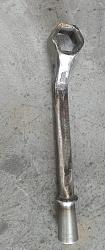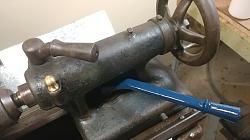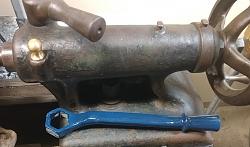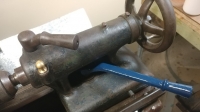the lathe needed a spanner to lock and unlock the tailstock. I fabricated this based on photos of similar vintage ones (LeBlonde style).
The hex was made by cutting flat bar (30x6 MS) at the length of the flats on the hex nut (1 1/16" AF) - the flatbar was cut mostly through, so I could could "wrap" it around the nut, with the open cut facing outside the nut.
The open cuts were then filled with weld to create a hex socket with a wall thickness of 6mm.
The handle was made of 2 pieces, the turned section made on the SB13 from some tough mystery steel from the scrap bin, and the shaft of the handle was some 12 x 18mm offcut from shear reject. The crank in the shaft was made by partially cutting the shaft, and filling the cut with weld. A double J bevel was formed for welding the turned handle to the shaft, and a V bevel was used to weld the hex to the shaft.
The first photos show the finished welding, with some "filler" weld added here and there to build up the profile I wanted.
The second set show the painted spanner in use on the lathe.
overall length is approx 250mm (10")



 LinkBack URL
LinkBack URL About LinkBacks
About LinkBacks







 Reply With Quote
Reply With Quote




Bookmarks